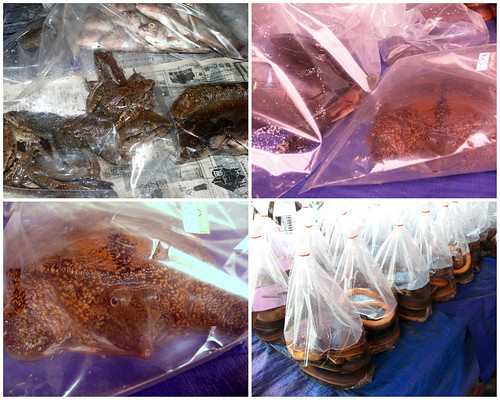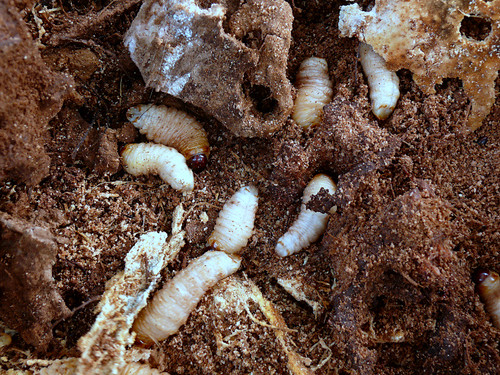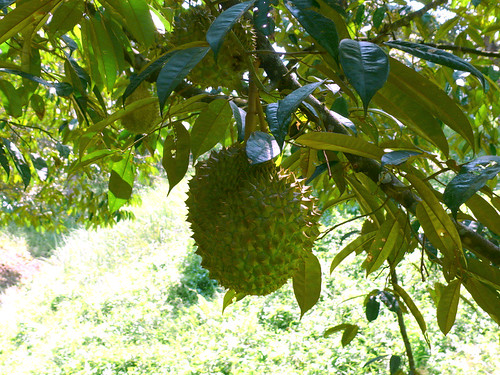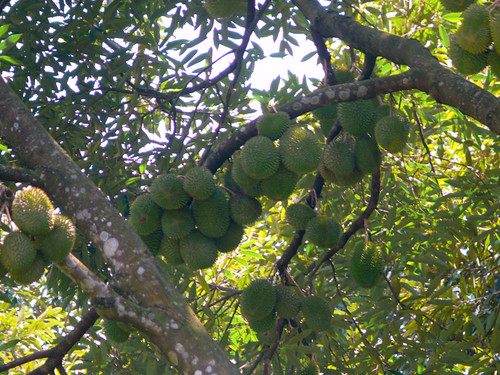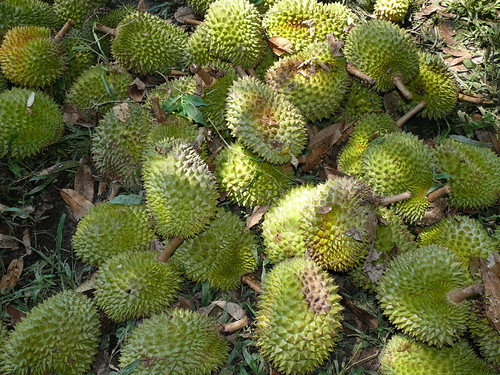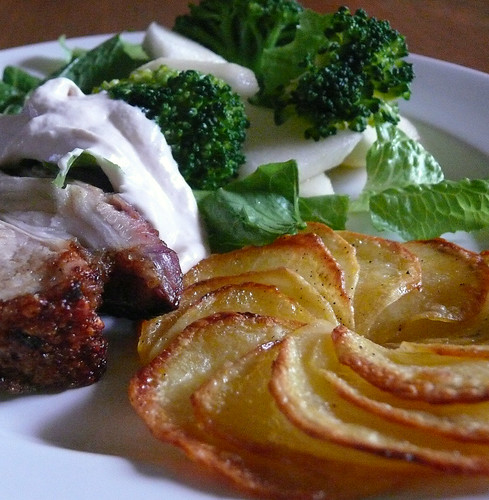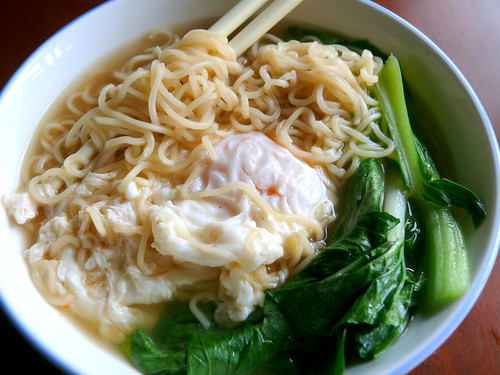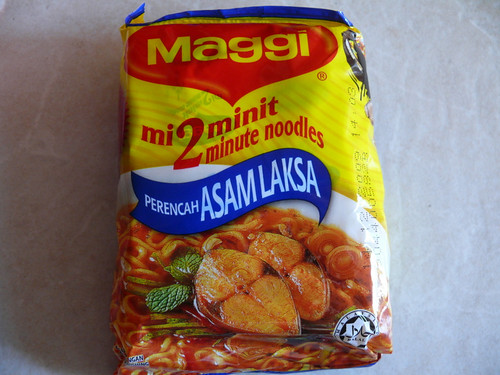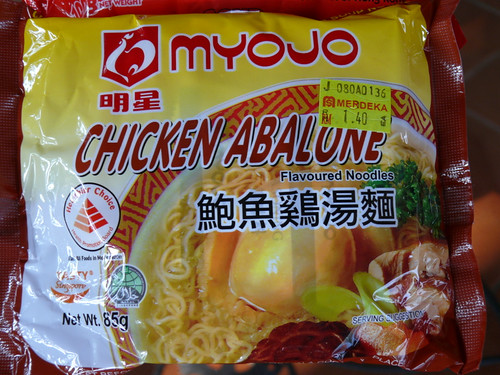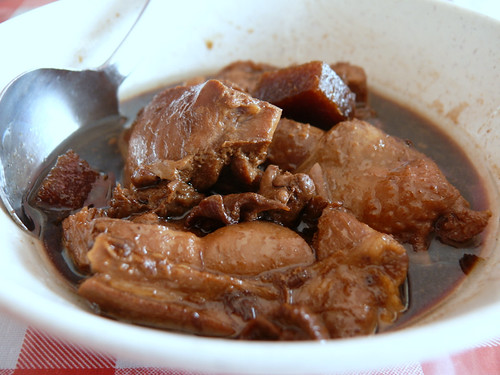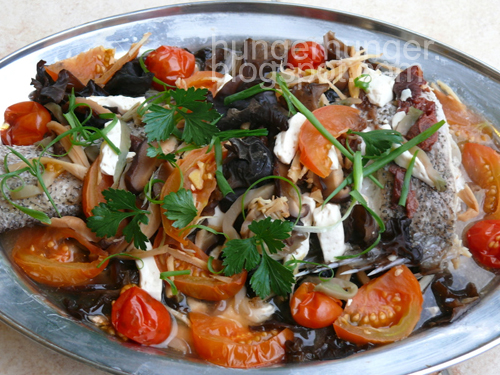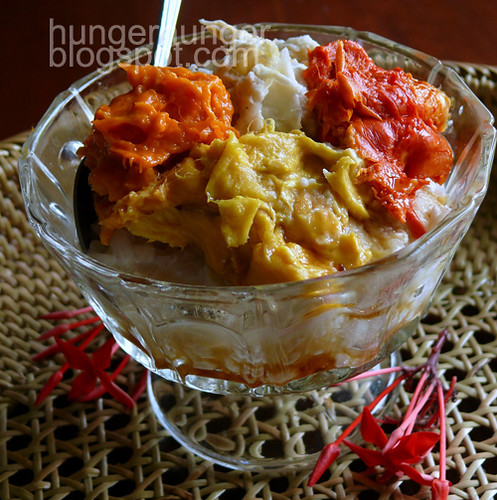
Sticky rice with wild jungle durians, the dalit
Every corner I turned yesterday, I saw durians. Less than a minute away is Taman Mesra, and the new mom-and-pop grocery store called Mun Cheong (next to LuMen Bookstore--I refuse to spell that 'lumen') sells durians (RM6/kg). The coffee shop next to it and the one behind too. A friend had just given us 3 durians on Sunday ("From my sister's fruit orchard in Kota Belud") and 2 are still sitting on my patio (durians are not fruits you keep inside the house) but I had to get the durians from the small coffee shop behind Mun Cheong, because last year they had some excellent durians. So I went there, thinking of a story to tell my Hub so he wouldn't know I've bought durians again (Eat them before he comes home! Tell him I found them outside our house! Tell him we have a durian tree we didn't discover until now!), when a car stopped and out jumped J, who also loves the durians from that shop (The durians are from the shop keeper's durian farm in Papar. ). I felt assured that I wasn't splurging; buying durians is a necessity. I bought a large 2 kg fruit for RM16/US$4.30 (his durians are RM8/US$2.10/kg for large fruits and RM7/US$1.90/kg for smaller fruits) and am surprised because for the same size, a Thai hybrid durian is about 3 kg. It confirms my belief that even though Thai hybrid durians are fleshy, most of the weight is in the thick shells.
I got home just as Hub was pulling into the garage and guess what? He was holding two durians, given by another friend whose friend has a durian farm too. Everyone has a durian farm except us, but we are lucky that we have generous friends. We opened my durian. It was gorgeous. It was the thin-shelled, spiky-thorned, white-fleshed original Malaysian durian that hadn't been modified by Thai botanists. The flesh was not too thick or thin (but can be thicker) but the flavor was intense. The flesh wasn't wet and there was no hard layer next to the skin. But wait. I tasted bitterness behind the sweetness. I stopped. I turned to the durians from Sunday and the ones Hub had brought home and devoured those. I don't like bitter durians, unlike most durian lovers. If I want bitter, I can eat bittergourd.
The wondrous thing about durians is that each fruit, even if it's from the same tree, can taste slightly different, each with a different blend of flavors and intensity. It is truly an amazing fruit, did I tell you that already? But if you've tried durians and hate them, chances are you ate Thai durians, which Malaysians, Indonesians and Singaporeans (united about one thing for a change) dislike. Thai durians are bred for export and grown to reduce their flavor and increase the thickness of their flesh (making Thai durians taste like sweet potatoes) and these two characteristics of Thai durians are worsened by the picking of the unripe fruit (genetically modified to have shorter, blunt thorns and short trees) unlike Malaysia durians which are allowed to ripen and drop. Malaysian durians, however, are genetically improved to have thick flesh without loosing their flavor, so that's something we've done right. Read one of my impassioned posts on durians here. Now that I've made my preference clear, let's move on.
So I have these durians and not enough stomach capacity. I have already made durian fresh cream cakes last weekend. A West Malaysian told me once that he eats his durian with plain white rice. In the Indochinese peninsula, durian is eaten with sticky rice, coconut cream and gula melaka. Since durians, gula melaka and coconut cream are my top favorite food, I spent an hour searching for the right recipe . Most of the recipes tell you to soak the rice for hours, steam it without coconut milk, and make a sauce with the gula melaka, blended durian flesh (ruining the durian) and coconut milk . I am not one to wait 3 hours for my rice to soak, and I prefer to have my rice with coconut flavor (but not too oily, so I used the second squeeze of the coconut) and taste the texture of my durian, so I didn't blend the flesh or cook them into a sauce. As for the salt, the Thais have a habit of salting their desserts very heavily and I think that's a strange and harmful habit. First of all, the sweetness is confused with the saltiness (if you've been to Thailand, you'll know that they don't add salt like we do, in a trace, they add enough to make their desserts salty. Yes, today I'm not bashing Singapore.). Second, the heavy addition of salt means you need more sugar to taste any sweetness. There's this disease called dia-be-tes.
Just as I was about to publish post, Hub walked in, holding two big plastic bags of wild durians, called dalit. He was in Papar this morning, and he reported that the town if filled with durians. I made a quick switch of the dessert, chucked out most of my white durian and replaced them with the colorful wild durians.
Here are the 3 types of wild durians from Papar: yellow, orange and reddish-orange. The yellow was great, thick-fleshed, creamy and flavorful, the orange was too wet, thin-fleshed and had a strong alcoholic flavor (which many durians have) but the orangy-red ones were my favorite: full, intense wild durian flavor (which puts the regular durians to shame) and so creamy that it was waxy. But it's not just the intense flavor or creaminess that makes wild durians so heavenly.If you sniff the shell of an unopened wild durian, it smells like regular durians. But when you taste it, the wild durian is infinitely better, with blended layers of different flavors that can taste like a combination of roasted peanut butter, vanilla, candy floss and many other flavors that I am at a loss to describe.

I read a comment somewhere that durians do not look like fruits because because they look 'organic'. These wild durians sure look like kidneys.
Take a look at the most exotic durian I've ever tasted, the red durian.
So what do I think of sticky rice with durian? It was delicious, heavenly, unbelievable. Maybe because the wild durian flavor was so strong, the gula melaka and the coconut cream didn't mask the flavor of the durians but instead the cream blended with the rice and the durians while the gula melaka gave extra sweetness to the dessert. Each of the wild durians had its own special flavor. I felt so privileged eating them. Heaven. But the dessert also made me feel heady, hot, like I've been drugged or intoxicated, and very full. I think I can omit the rice next time and just add the coconut milk and sugar syrup. And I think it's time to cool off durians. Until this weekend that is.
Sticky Rice With Wild Durians
Durian flesh (mashed if like), chilled
1 cup uncooked glutinous rice
1 1/4 cup thin coconut milk*
1 cup thick coconut milk*
1/3 cup gula melaka syrup
a good pinch of salt
* Add 1 cup room temp water to 400 g (from 1 coconut) shaved coconut. Massage the coconut and squeeze the milk out, with a sieve over the container. You will get more than 1 cup. Chill this in the fridge. Add 1 1/2 cups water to the squeezed coconut, massage again to release the milk, squeeze over a sieve into a container.
1. Wash the rice, place into a steaming plate and sprinkle a pinch of salt over. Add 1 1/4 cups (or 1 cup if you like your rice with a bite) of the second squeeze of coconut milk to the rice and steam at high heat for about 8 minutes. Remove, fluff and let cool.
2. To serve, scoop 2-3 spoonsful of the rice into a small bowl. top with lots of durian flesh, pour some sugar syrup over and finally a generous amount of the thick coconut milk over. Oh. My. Goodness.












